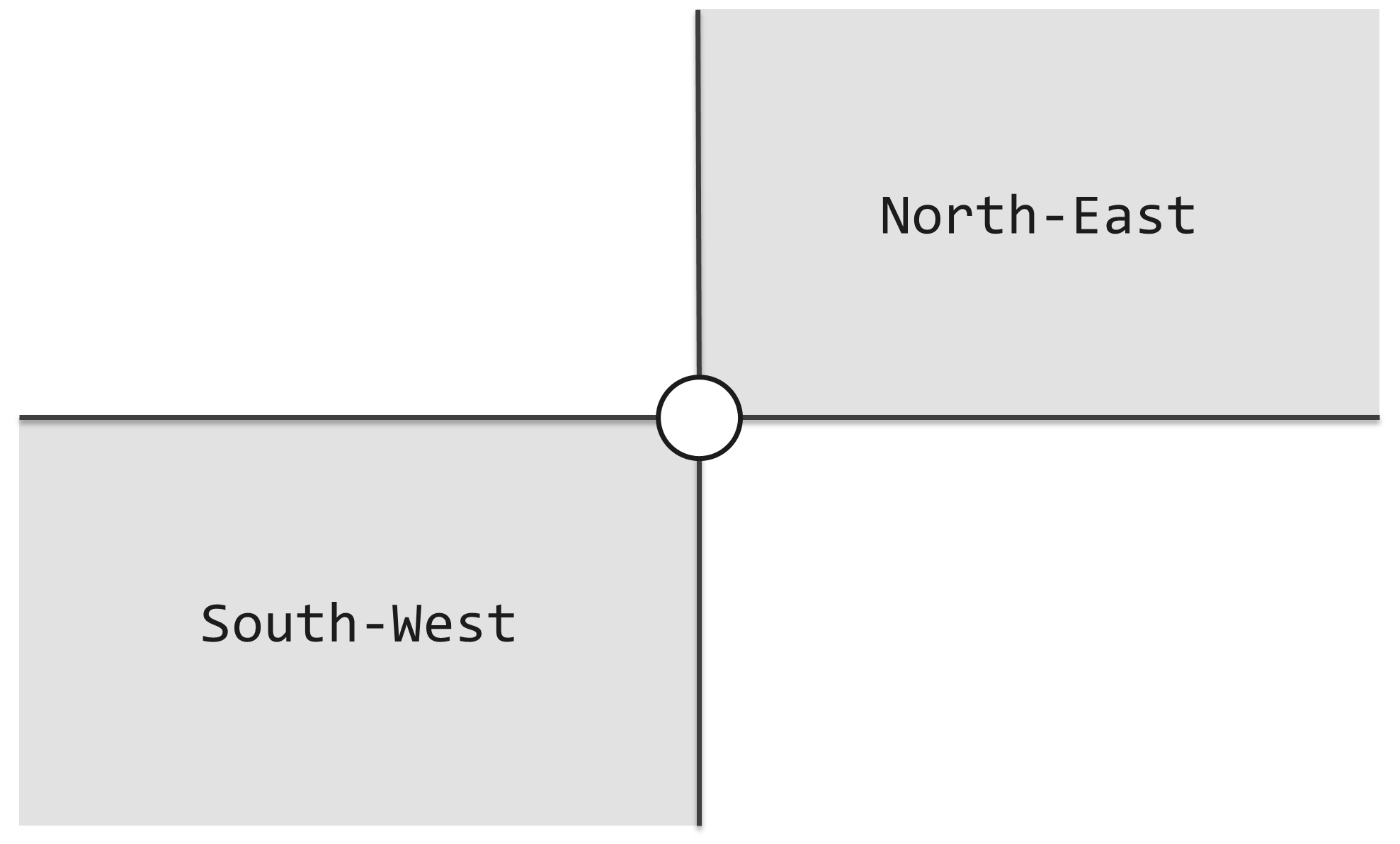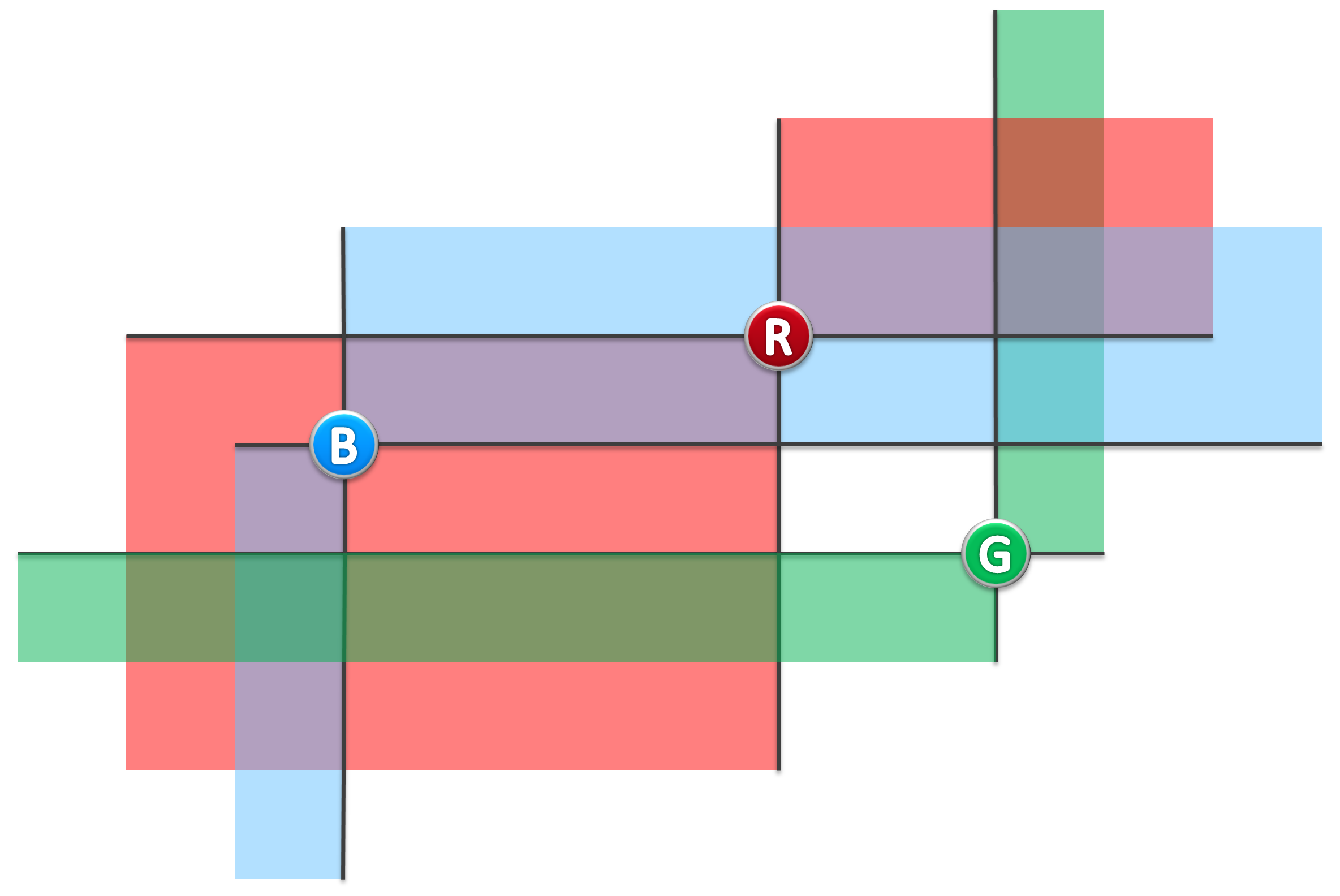Tsinghua OJ:燈塔(手排+歸併排序)
燈塔(LightHouse)
Description
As shown in the following figure, If another lighthouse is in gray area, they can beacon each other.

For example, in following figure, (B, R) is a pair of lighthouse which can beacon each other, while (B, G), (R, G) are NOT.

Input
1st line: N
2nd ~ (N + 1)th line: each line is X Y, means a lighthouse is on the point (X, Y).
Output
How many pairs of lighthourses can beacon each other
( For every lighthouses, X coordinates won't be the same , Y coordinates won't be the same )
Example
Input
3
2 2
4 3
5 1
Output
1
Restrictions
For 90% test cases: 1 <= n <= 3 * 105
For 95% test cases: 1 <= n <= 106
For all test cases: 1 <= n <= 4 * 106
For every lighthouses, X coordinates won't be the same , Y coordinates won't be the same.
1 <= x, y <= 10^8
Time: 2 sec
Memory: 256 MB
Hints
The range of int is usually [-231, 231 - 1], it may be too small.
描述
海上有許多燈塔,為過路船隻照明。

(圖一)
如圖一所示,每個燈塔都配有一盞探照燈,照亮其東北、西南兩個對頂的直角區域。探照燈的功率之大,足以覆蓋任何距離。燈塔本身是如此之小,可以假定它們不會彼此遮擋。

(圖二)
若燈塔A、B均在對方的照亮範圍內,則稱它們能夠照亮彼此。比如在圖二的例項中,藍、紅燈塔可照亮彼此,藍、綠燈塔則不是,紅、綠燈塔也不是。
現在,對於任何一組給定的燈塔,請計算出其中有多少對燈塔能夠照亮彼此。
輸入
共n+1行。
第1行為1個整數n,表示燈塔的總數。
第2到n+1行每行包含2個整數x, y,分別表示各燈塔的橫、縱座標。
輸出
1個整數,表示可照亮彼此的燈塔對的數量。
樣例
見英文題面
限制
對於90%的測例:1 ≤ n ≤ 3×105
對於95%的測例:1 ≤ n ≤ 106
全部測例:1 ≤ n ≤ 4×106
燈塔的座標x, y是整數,且不同燈塔的x, y座標均互異
1 ≤ x, y ≤ 10^8
時間:2 sec
記憶體:256 MB
這裡歸併排序只能過掉百分之九十五的樣例;
發部落格的目的是儲存自己的歸併模板 具體優化需要用到樹狀陣列#include<stdio.h>
#define maxn 4000005
struct node
{
long long x,y;
}a[maxn];
long long s[maxn],ss[maxn],count;
void qsort(node aa[],int l,int r)
{
if(l<r)
{
int x=l,y=r;
node temp;
temp.x=aa[x].x;
temp.y=aa[x].y;
int t=aa[x].x;
while(x<y)
{
while(x<y && t<aa[y].x)
y--;
a[x].x=a[y].x;
a[x].y=a[y].y;
while(x<y && aa[x].x<t)
x++;
a[y].x=a[x].x;
a[y].y=a[x].y;
}
a[x].x=temp.x;
a[x].y=temp.y;
qsort(aa,l,x-1);
qsort(aa,x+1,r);
}
}
void merge(long long *s,long long *ss,int l,int mid,int r)
{
int i=l,j=mid+1;
int k=l;
while(i<=mid && j<=r)
{
if(s[i]<s[j])
{
ss[k++]=s[i++];
count+=r-j+1;//求順序對
}
else
ss[k++]=s[j++];
}
while(i<=mid)
ss[k++]=s[i++];
while(j<=r)
ss[k++]=s[j++];
for(i=l;i<=r;i++)
s[i]=ss[i];
}
void mergesort(long long *s,long long *ss,int l,int r)
{
int mid=(l+r)/2;
if(l<r)
{
mergesort(s,ss,l,mid);
mergesort(s,ss,mid+1,r);
merge(s,ss,l,mid,r);
}
}
int main()
{
int n,i;
scanf("%d",&n);
for(i=1;i<=n;i++)
scanf("%lld%lld",&a[i].x,&a[i].y);
qsort(a,1,n);
for(i=1;i<=n;i++)
s[i]=a[i].y;
mergesort(s,ss,1,n);
printf("%lld\n",count);
}